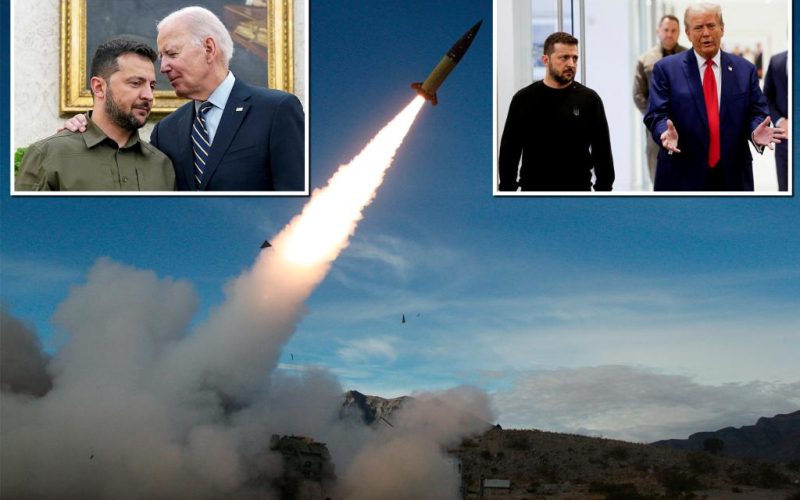WASHINGTON — President Biden has authorized Ukraine to use powerful long-range ballistic missiles to strike deeper inside Russia — but experts fear it may be too little, too late.
The move, announced Sunday, lifts a restriction on firing the American-made Army Tactical Missile System (ATACMS), which have nearly double the striking distance of most of the missiles in Ukraine’s possession.
However, the 190-mile range missiles can only be used to defend Ukraine’s foothold in Russia’s Kursk region, multiple outlets have reported.
The Kremlin has amassed 50,000 Russian and North Korean troops to the region in western Russia to retake the territory seized by Kyiv in its surprise incursion earlier this year.
The Institute for the Study of War’s George Barros said that while the Kursk decision was “a good thing,” lifting Washington’s restrictions on ATACMS use in the rest of Russia would have a more consequential effect.
“The general arc is toward the right decisions — but the right thing is sort of a day late and a dollar short,” Barros told The Post.
“The incrementalism and death by 1,000 cuts has been the defining schema for how we’re doling out support for Ukraine in this war and it’s unfortunate,” he added.
Meanwhile, a map produced by the ISW has identified 245 known Russian military objects reachable by ATACMS — 17 of which lie in the Kursk region that are now fair game for Ukrainians to attack.
Among those military assets are the Air Base Kursk Vostochny and 14th Fighter Aviation Regiment, and various brigade headquarters — all of which Russia has likely cleared of any sustained presence but are still relied upon for war operations.
The Biden administration previously cited Moscow’s moving of assets deeper into Russian territory as a reason against green-lighting ATACMS in Russia, but Barros said the bases and infrastructure continue to host infrastructure critical to Russia’s fight — such as refueling stations — that can make Russia’s job harder.
“The Russians have engaged in the tactic where though they might not always have as many aircraft [parked at] air bases anymore, they still use the air bases,” he said. “They’ll send aircraft there quickly to fuel or that sort of thing, then fly back to a different base. So the use of the airbase still a good thing [to target.]”
There are also weapons and logistics warehouses in the region, as well as regimental and unit bases that, if targeted, could further deplete Russia’s supplies and resupply capabilities, according to ISW.
Still, Barros said that the most valuable targets do not appear on the ISW map, which only identified established military assets — and not the positions of Russian and North Korean forces in the region.
“There are things that the Russians stood up, that they are actively using, that the map does not show,” he said. “Anywhere you have from frontline forces operating, you’re going to have command and control posts, you’re going to head ammunition depots [that could be targeted.]”
The map also ignored infrastructure used by both Russian forces and civilians that are fair game under the laws of war. For example, public railroads serve a “dual-use” purpose by enabling the shipment of weapons, munitions and supplies to the frontlines.
Targeting railroads is of particular importance after intelligence revealed North Korea is shipping its largest self-propelled 170 mm howitzers to western Russia via train. Destroying the railways in Kursk could prevent the artillery systems from reaching the region — or at least seriously delay their delivery.
“If those deployed to the Kursk area, for example, those are going to have to go to a rail terminal someplace, somewhere, and then they’re going to have to close the distance to go to their final firing positions,” Barros said.
More coverage on the Ukraine war
Ukraine could also allow the howitzers to reach the area before destroying them — and could even use their movements to determine the locations of Russian and North Korean troops, Barros said.
“Ukrainian attackers would be able to, for example, strike those artillery pieces when they’re at the rail yard getting taken off the rail cars and put onto the road to go drive to their firing positions,” he said. “That would be a legitimate military target, as well.”
Barros hopes the change in administration could offer a needed switch from the incremental nature of Biden’s policy changes.
“[The Biden administration] has continued this trend, and I think with a new administration — provided that they keep us on the right track — there could be positive change,” he said.
“There’s risk, of course, with change, but there’s also opportunity.”
Though President-elect Trump has been largely mum on how he envisions US policy toward Ukraine’s fight under his leadership, Barros said he is hopeful about the Trump-Vance administration.
“It would be my hope that with a new cadre of officials and executives who are not married to the previous way of doing business, who are not married to the existing policy and the schema for metering out support on this drip feed … that we’ll have an opportunity to go for a more sound and stronger strategy.”








